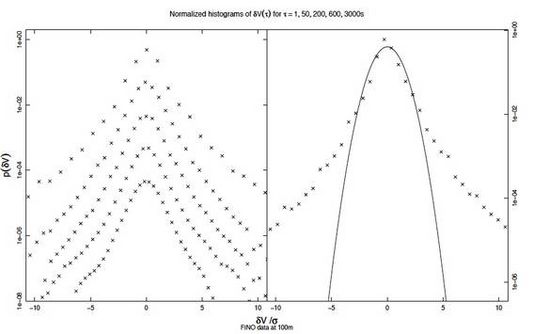Atmospheric turbulence
Atmospheric turbulence
Characterization of atmospheric wind speeds
A good description of atmospheric wind fields is of crucial importance in the field of wind energy, however these fields are complex non-stationary structures and therefore very difficult to characterize. We focus on statistical descriptions of the turbulent part of the wind, of particular interested are gusts and the intermittent behavior of wind. The gusts are related to the unsolved problem of turbulence and small scale intermittency, which leads to heavy tailed statistics and therefore gives high probability for large fluctuations. These fluctuations can lead to unexpected and numerous extreme events. All this has implications for a correct description of the wind profile of the boundary layer and definitely has influences on the wind turbines in form of mechanical loads and therefore in the lifetime of the machines. Usually the turbulence is described just by means of the so called turbulence intensity, but such a quantity based on the standard deviation of the wind speed distribution (and also the mean speed usually over 10 minute averages) is clearly insufficient and very limited for the description of non-Gaussian statistics. Our approach is to give a more general description of wind fluctuations based on speed increments, knowledge of the probability density functions (PDFs) of such increments give a better and more complete description of the wind statistics.
 |
| Figure 1: PDFs of wind speed increments δV (t, τ ) = v(t + τ ) − v(t). The left side shows the PDFs for different scales τ =1-3000s (from top to bottom). The right side shows the comparison with a gaussian distribution. The data come from the research platform FINO I |



